by Celeste Lipford and Terry Lipford - last updated on 10/3/2025
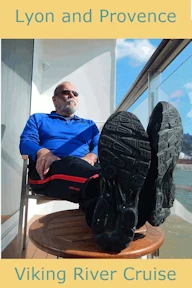
We were onboard a Viking River Cruise on the River Rhone (click here to view our Trip Overview Page), and Avignon was one of the initial stops of the cruise.
Avignon, nicknamed 'City of Popes' because it was home to seven popes from 1309 to 1377, as well as being located in an area where the Roman Empire constructed numerous buildings, arenas, and other facilities in, is an interesting place to start this trip.
But I think that it would make far more sense for me to create this trip blog in the manner in which Viking River Cruises does it - to generate a "day by day" narration of where we were, what took place, and what our thoughts were, so lets switch to that format.
As I previously described, this was our "arrival day" and as we were in the first wave of arriving passengers, we had to wait a bit for our cabins to be cleaned and prepared. Viking has what they call an "embarkation buffet" from 11AM to 3PM, so that everyone who arrives can entertain themselves with food or drink until their cabins are ready to be occupied.
Our game plan is always the same, we unpack, get a 1.5 or so hour nap, wake & shower, and then go out and hike in order to get as tired as possible (although, we generally take 1/2 of a sleep aid to insure that we get a full night's sleep) so that the first nights in Europe are not a "sleepless" event! This approach works quite well for us, as we have always had good results in jet-lag removal.
Keep in mind that this day's exploration, was really more about us getting tired and being able to walk about this ancient city, and not about "visiting" any specific Avignon sites.
The Palace of the Popes in Avignon, France, is one of the most significant Gothic buildings in Europe and has a fascinating history rooted in the medieval church's politics. Built in the 14th century, it served as the seat of the Papacy for nearly 70 years during the Avignon Papacy (1309-1377), when seven successive popes resided in Avignon instead of Rome due to political instability in Italy.
The construction of the palace began under Pope Benedict XII in 1335 and was expanded by his successors, particularly Pope Clement VI, who made the palace an opulent symbol of papal power. The site was chosen for its defensibility, built on a rocky outcrop, and the palace reflects this with its fortress-like walls. It is divided into the "Old Palace" (built by Benedict XII) and the "New Palace" (constructed by Clement VI), blending both religious and military architecture.
By the late 14th century, the popes returned to Rome, but the palace continued to play a role in European history, later used as a fortress and barracks. Today, it stands as a UNESCO World Heritage site and a major tourist attraction, showcasing both the political and cultural power the medieval papacy wielded.
Key features include grand frescoed halls, the Pope’s private apartments, and the Chapel of St. Martial. The palace’s imposing architecture and its connection to this pivotal moment in church history make it a must-see for visitors interested in Gothic art and medieval Europe.
Papal Palace History
If you are interested in a more comprehensive history of the Palace, you should read the Wikipedia Article as it contains quite a bit more info, images, etc.
The Palais des Papes is an historical palace located in Avignon, Southern France. It is one of the largest and most important medieval Gothic buildings in Europe. Once a fortress and palace, the papal residence was the seat of Western Christianity during the 14th century. Six papal conclaves were held in the Palais, leading to the elections of Benedict XII in 1334, Clement VI in 1342, Innocent VI in 1352, Urban V in 1362, Gregory XI in 1370 and the Anti-pope Benedict XIII in 1394.
The disagreements within the Catholic Church that led to the "Western Schism" are diverse. Pope Gregory XI actually returned the Papacy to Rome in 1377, but when he died in 1378, Church politics led to a serious dispute and the era of the "anti-popes" began. If you are interested in reading more about this time frame, please go to this Wikipedia Page to read about the history of the Western Schism.
More Info for the City of Avignon
Image Credits:
The Palais is actually two joined buildings: the old palais of Benedict XII, which sits on the impregnable rock of Doms, and the new palais of Clement VI, the most extravagant of the Avignon popes. Together they form the largest Gothic building of the Middle Ages, it is also one of the best examples of the International Gothic architectural style. The construction design was the work of two of France’s best architects, Pierre Peysson and Jean de Louvres and the lavish ornamentation was the work of two of the best students of the School of Siena (Italy), Simone Martini and Matteo Giovanetti.
With 15,000 square metres (160,000 sq ft) of floor space, the Palais is the largest Gothic palace in all of Europe and, due to its many architectural merits, one of the most important in the world. These merits were highlighted by Viollet-le-Duc, author of “Dictionnaire raisonné de l’architecture française du XIe au XVIe siècle” (Dictionary of French architecture from the 11th to the 16th century), who referred extensively to the Palais, including the thickness and height of its towers, the strength of its crenelated walls, the use of arcs for support on its façades and its ability to withstand heavy and drawn-out sieges.
In the windows of the Papal Palace in Avignon, you'll find a fascinating detail that connects the present to the past: original hand-blown glass panes set within their historic leaded frames. These windows are a testament to the craftsmanship of centuries ago, where each pane was meticulously created by skilled artisans. If you look closely, you can see the subtle irregularities in the glass, a hallmark of its hand-blown origin. These imperfections lend the windows a unique charm, refracting light in delicate, unpredictable patterns.
Standing by these windows, it’s hard not to be struck by a sense of history. The view from them offers a sweeping panorama of Avignon, its rooftops, streets, and surrounding landscapes stretching out below. It's humbling to imagine how many Popes, seated within this very palace during its tenure as the seat of the Papacy, gazed out at this same cityscape.
Did they feel the weight of their responsibility as they surveyed the town? Did they seek solace in the same beauty that captivates us today? The connection forged by these simple, yet profound moments of reflection makes the experience of standing at these windows truly special—a tangible link to a bygone era.
Pope Urban V made a significant contribution to the architectural grandeur of the Papal Palace by completing the main courtyard, known as the Cour d'Honneur (Court of Honor). His vision and efforts brought a sense of cohesion and elegance to this central space by enclosing it with additional structures. These new buildings not only enhanced the aesthetic appeal of the courtyard but also reinforced its functionality as the heart of the palace.
The Cour d'Honneur became a focal point for ceremonial gatherings, administrative activities, and the daily workings of the Papal court. Its enclosed design offered privacy and security while maintaining an air of majesty befitting the residence of the pontiff. This architectural achievement reflects Urban V's dedication to enhancing the palace as both a spiritual and administrative center.
The courtyard's symmetrical layout and imposing facades remain a testament to the grandeur of papal authority during the medieval period. Today, the Cour d'Honneur is a centerpiece of the Papal Palace's design, symbolizing the blend of religious significance and architectural splendor that characterizes this historic landmark.
Pope Clement VI commissioned the construction of this magnificent 52-meter-long Grand Chapel to serve as the primary site for papal acts of worship during his reign. As the spiritual and ceremonial heart of the papal court, the Grand Chapel was not only where the Pope conducted daily worship but also where some of the most significant liturgical events of the time took place.
Designed to reflect the grandeur and authority of the Roman Catholic Church, the chapel’s architecture and decoration showcased the finest craftsmanship of the period, featuring intricate frescoes, elaborate altars, and soaring vaulted ceilings. The space was adorned with religious iconography that underscored the power and divine right of the papacy, reinforcing its role as the epicenter of Catholic devotion.
Given its importance as the Pope’s personal place of worship, the Grand Chapel became the symbolic heart of Roman Catholicism, where theological decisions were made, religious ceremonies were conducted, and the Pope himself sought divine guidance. Its historical and artistic significance endures, standing as a testament to the influence of Pope Clement VI and his vision for the Church during a pivotal era in European history.
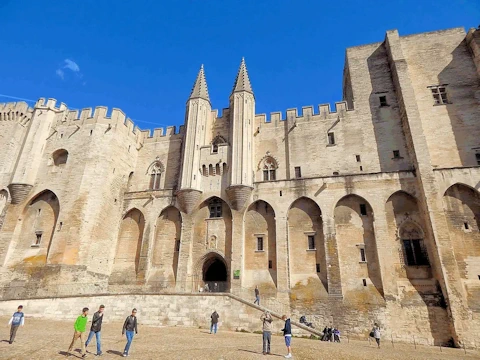 Papal Palace Entrance
Papal Palace Entrance This is the main public entrance into the Palace, incredible structure isn't it?
The Palace is a historical and architectural landmark and primarily a tourist attraction, attracting around 650,000 visitors per annum, putting it regularly in the top ten most visited attractions in France. It also houses a large convention centre and the archives of the département of Vaucluse, which include a research centre on the papacy of Avignon, organized jointly by the École française de Rome and the institut de recherche et d'histoire des textes.
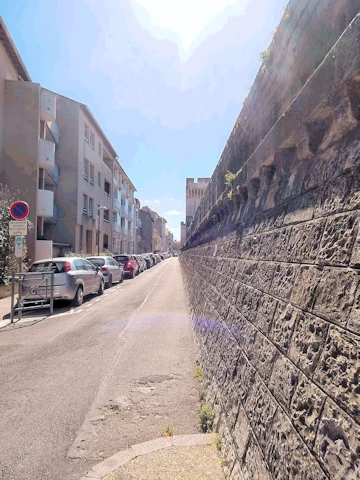 Avignon City Walls
Avignon City Walls The city is surrounded by 4.3 miles of walls that were obviously built to keep people out ! Considering the age of these walls, they are in very good condition. I have no idea of what may have happened here during the 20th century world wars.
The city walls are 4,300 meters in length, and were originally 8 meters high, fitted out with crenellations and machicolations. The city walls are reinforced by 35 great towers and 50 smaller ones. Seven gates allowed the city entrance, they are now fourteen. Waters from Durance and Sorgue rivers supplied the moat.
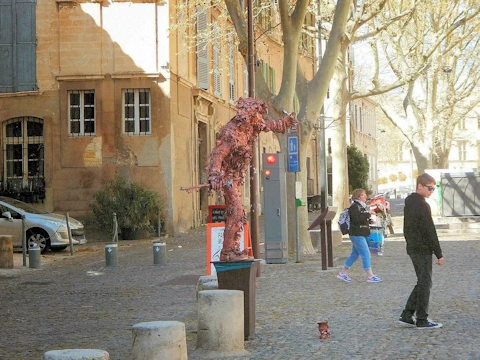 Street Artists of Avignon
Street Artists of Avignon There were a number of street performers in the square adjacent to the Palace, all of them competing for contributions from tourists.
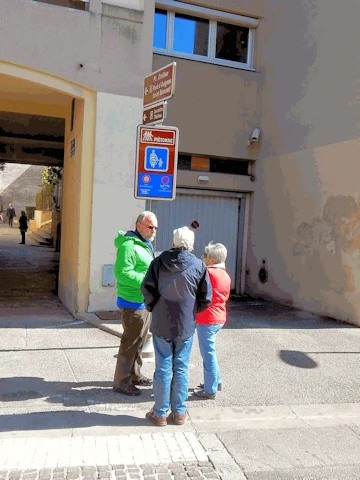 Quick Review of the Day's Game Plan
Quick Review of the Day's Game Plan I was relating some historical facts to my in-laws, and they were taking it all in. Or it may have been that we were considering heading back to the cruise ship for lunch? Whatever it was, we worked it out while Celeste snuck in a picture of us yakking.
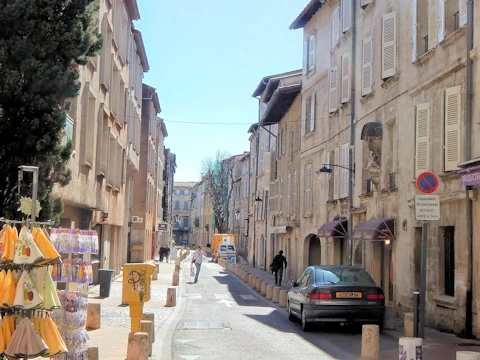 Avignon Street Scene
Avignon Street Scene Because this was still day one of our Viking Cruise, and probably because we were all still a bit jet lagged and tired of sitting, we did quite a bit of hiking around the city. Found an espresso shop and all of us enjoyed a good French espresso and some pastries.
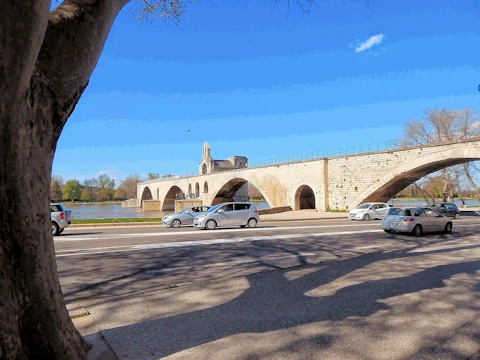 Pont Saint-Bénézet
Pont Saint-Bénézet This is the Pont Saint-Bénézet, one of the original Avignon bridges (construction commenced in 1177), which used to link the Papal Palace (which is just to the right of the bridge) to the west bank of the River Rhône.
Repeated River Rhône floods tore down this bridge, and finally Avignon decided to just leave it as a partial bridge and not to keep rebuilding it.
Click here to read the Wikipedia Page for Pont Saint-Bénézet.
The following list contains links to all of our other French Destinations & Information Pages, click any link to go to that page.
Note: All images featured on this page are the exclusive property of Just Traveling Thru, LLC, unless otherwise stated. When images from external sources are used, full credit is given to the original creator, along with a link to the specified license or usage terms. We are committed to respecting copyright and intellectual property rights, ensuring that all third-party images are properly attributed. If you have any questions regarding image ownership or usage rights, please feel free to contact us.
Affiliate Links: We may earn a commission if you make a purchase through one of our affiliate links. This helps support our travel content — thank you!
Content: To review any of our content, make suggestions and/or comments, please click the "About" menu link at the top of this page. You will find our "Contact Us" link on that drop-down menu.